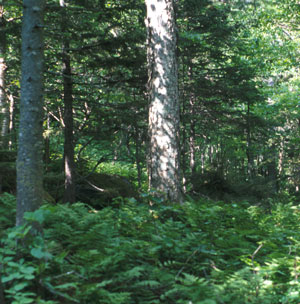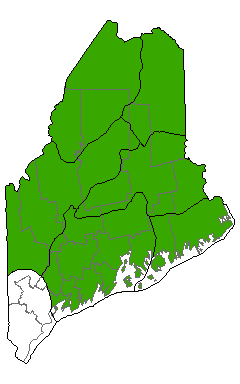DACF Home → Bureaus & Programs → Maine Natural Areas Program → Communities, Plants, and Animals → Natural Community Fact Sheets → Spruce - Northern Hardwoods Forest
Printer Friendly Fact Sheet - 900 KB pdf (Get a free copy of Adobe Acrobat Reader)
Spruce - Northern Hardwoods Forest
Scientific Name: Spruce - Northern Hardwoods Forest; State Rank: S5

- Community Description
- Soil and Site Characteristics
- Diagnostics
- Similar Types
- Conservation, Wildlife and Management Considerations
- Distribution
- Characteristic Plants
- Associated Rare Plants
- Associated Rare Animals
- Examples on Conservation Lands You Can Visit
Community Description: This mixed forest type is characterized by red spruce and yellow birch, or less often another hardwood (sugar maple, red maple, or beech). Scattered large supercanopy white pine trees are occasional. Balsam fir and paper birch are common, typically as smaller trees, and hemlock may be an associate at some sites. The sapling/shrub layer may be fairly well developed (20-40% cover), with striped maple and saplings of canopy species; shrub species vary among sites. The herb layer ranges from sparse to dense but is usually >15% cover, divided between forbs, ferns, and regenerating trees, with dwarf shrubs virtually absent. The bryoid layer is patchy and locally well developed, with bryophytes far more abundant than lichens. As is typical in mesic forests in Maine, three-lobed bazzania is a frequent bryophyte. Back to top.
Soil and Site Characteristics: These forests occur on cooler microsites from near sea level to 2200’. They are usually on hillslopes, ranging from lower to upper slopes and from gentle to steep (up to 50%). The soils are typically well drained, sometimes somewhat excessively drained, sandy to loamy in texture, with pH 5.0-5.4. Back to top.
Diagnostics: Sites are distinguished by a mixture of red spruce and northern hardwoods (most often yellow birch) in the canopy; conifer and deciduous components exceed 25% cover each. Back to top.
Similar Types: Northern Hardwoods Forests are more strongly deciduous. Spruce - fir forest types can be similar but have <25% cover of northern hardwood species. Both of these types can be contiguous with this type and may intergrade with it. Back to top.
Conservation, Wildlife and Management Considerations: Nearly all forests of this type have been harvested in the past, and at many sites the spruce has been selectively removed. As a result, the canopies of such sites are more often indicative of Beech - Birch - Maple Forests, with spruce and fir more common in the understory than in the canopy. Sites with relatively little human disturbance are rare but are moderately well represented on conservation lands.
This type provides nesting habitat for a large number of passerine bird species, including sharp-shinned hawk, cape may warbler, black-throated blue warbler, black-throated green warbler, blackburnian warbler, scarlet tanager, spruce grouse, Swainson's thrush, northern parula, and ovenbird. The globally uncommon early hairstreak butterfly uses beech as its larval host plant. Back to top.
Distribution: Most characteristic of the New England - Adirondack Province, and extending westward from Maine; found to a lesser extent in the Laurentian Mixed Forest Province. Landscape Pattern: Matrix. This type is intended to represent forests that are truly ‘mixed’ at a stand scale, rather than large blocks containing a mosaic of distinct conifer and hardwood stands. For the latter example, the ‘Spruce – Northern Hardwood Forest Ecosysystem’ is a more appropriate mapping unit. Back to top.


Characteristic Plants: These plants are frequently found in this community type. Those with an asterisk are often diagnostic of this community.
- Canopy
- Balsam fir
- Red spruce*
- White pine*
- Yellow birch*
- Sapling/shrub
- American beech
- Balsam fir*
- Hobblebush*
- Mountain maple*
- Red maple
- Red spruce*
- Striped maple*
- Yellow birch
- Herb
- Northern wood-sorrel
- Spinulose wood fern*
- Starflower
- Bryoid
- Dicanum moss
- Flat-tufted feather-moss
- Pincushion moss
- Three-lobed bazzania
- Early hairstreak
Examples on Conservation Lands You Can Visit
| Example | County |
|---|---|
| Big Reed Pond Preserve | Piscataquis Co. |
| Black Mountain, Mahoosuc Public Lands | Oxford Co. |
| Chamberlain Lake Public Lands | Piscataquis Co. |
| Cranberry Brook, Moosehorn National Wildlife | Washington Co. |
| Western Mountain, Acadia National Park | Hancock Co. |